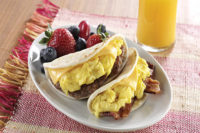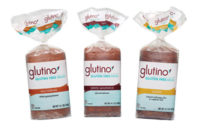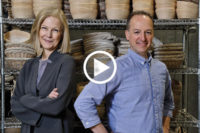State of the artisan














You’d think producing some 450 different bread varieties would require plenty of high-speed automation, but Tom Cat Bakery draws as much from its passion, inspiration and stamina to create an artful large line of flavorful, aromatic breads. An assortment of liquid levain, biga, poolish and solid levain, and the best possible ingredients also help.
From its new, handmade traditional pretzels with a popping-fresh, shiny brown crust to rich, sweet brioche, French rolls, wheat, rye and ficels, Tom Cat Bakery, Long Island City, N.Y., has been baking authentic French, Italian, German and other breads, scrumptious baguettes, whole-grain bâtards and specialty breads for more than 26 years.
Overall, the bakery produces about 450 different specialty items for bread baskets at New York’s leading restaurants, hotels and sandwich chains, and perhaps as many as 350 stock-keeping units (SKUs) a day. And it does so seven days a week, 24 hours a day and 365 days a year.
To say that’s a busy schedule is an understatement. Even though the artisan bakery doesn’t have a high-speed, automated plant, it purrs with energy. With a delivery fleet of more than 25 trucks that route the bread all over Manhattan three times a day, Tom Cat strives to be paws and whiskers above the rest when it comes to quality and organization. “We strive to be well-balanced in terms of great customer service, a good quality product, an agile support staff, a very good production team and so much more,” says James Rath, vice president and general manager. “I think growing the business responsibly and strategically is probably our biggest challenge, but we’re successful at it.”
Always “on the prowl” to improve and measure its work against the best in class, the 200-employee team at Tom Cat’s 45,000-sq.-ft. facility near the Queensboro Bridge puts its all into everything. “We’re never satisfied,” Rath says. “Being called Tom Cat, I guess we do have nine lives.”
The bakery has become synonymous with top-quality, hand-formed breads, sought out by some of the most famous chefs in the metro New York City area and beyond. Ingredients are authentic and as natural and fresh as possible. And it’s no wonder. The artisan taste really shows off the flair of the handmade (or as close to handmade as possible) items. “We have automated the bakery in many small ways, but where the craftsmanship is needed, it’s there,” says Rosita Moreno, vice president of sales and marketing.
The lithe artisan operation isn’t a one-line/one-product bakery, Rath emphasizes, so automation is used to expedite downstream processes, maintain economies and provide efficiencies, but doesn’t detract from the quality or craftsmanship of the product. “We make so many products that we have to jump in every direction,” he points out.
Not fully automated
Most customers have standing orders and call every day to add a few special breads. “Our customer service team updates orders until 3 p.m. every day,” Rath says. The bakery complies, and though a lot of the production is done by hand, it counts on the aid of five semi-automatic stress-free or low-stress production lines fed by two internal silos that hold 60,000 lb. of unbleached, unbromated flour. A sixth line is in the works. Operators are stationed at different points on each line, depending on what’s being produced, to lend their artistic hands to the results.
“It’s not here yet, but we have some additional equipment on the way,” he adds. “We’ve automated bits and pieces, but none of the five lines is what you’d call fully automated. The last piece of equipment we purchased was a machine to make silver-dollar-sized rolls because molding them by hand became too labor-intensive, and our other machines wouldn’t work with that small size roll. We are testing a machine that will help us make product at higher speeds with the same ability to handle highly hydrated, long-fermented doughs, which is always a challenge.”
Many New Yorkers recognize Tom Cat’s delicious baked goods by name and can easily spot its iconic logo of a black-and-white cat curled up near a tempting roll of bread. Emblazoned on the bakery’s silver delivery trucks, the logo can be easily spotted around town through the night, as the flavorful, fresh products are delivered within a 150 mile radius (or the tri-state area) of the city. Being a cat lover, bakery founder Noel Labat-Comess discovered the original logo plastered on an old produce crate and decided to recreate it for the bakery. Labatt-Comess retired from Tom Cat in 2008, and is pursuing other food-related interests while private equity firms Ancor Capital Partners of Fort Worth and Merit Capital Partners of Chicago have partnered with Tom Cat to guide the bakery in its future pursuits.
As if all of this isn’t enough, Tom Cat has been partnering with other bakeries and copacks for Brooklyn-based Z Crackers, which makes an assortment of hand-crafted flatbread crackers in savory and sweet flavors, such as Salt & Pepper, Kalamata Olive, Sweet + Salty, Cayenne + Cumin and Garlic + Basil. For the past six months, Tom Cat has also been distributing products for Free Bread, a nearby gluten-free bakery that started up in 2012.
“They are wonderful products,” Rath says. “Their bread is served in some of the best restaurants in New York City, including the Four Seasons Hotel, Le Bernadin and many others because of the incredible demand for gluten-free breads and the increase in celiac disease. They will be expanding their line soon to include pizza, focaccia and other varieties, but currently, they’re focused on offering gluten-free hamburger buns and sliced breads, as these seem to be the most in demand for great sandwiches.”
The vicissitudes of artisan
Besides helping other bakeries, what else has changed since Snack Food & Wholesale Bakery last visited the bakery nearly four years ago?
For starters, when the economy declined, a major movement almost exclusively emerged. “When we first started the bakery, we almost exclusively supplied white tablecloth-style restaurants and made mostly table breads and dinner rolls, but the client base changed during the economic downturn,” Rath says. “We went from a product-driven company to a customer-driven company. Customers tell us what they are trying to do, and we have become more attentive to their needs. They’re trend-setters, so we give them what they want and that works.”
Chefs started asking for more breads that can be used to make sandwiches, so Tom Cat switched gears from producing sweet goods, as it has for some time, to an assortment of sandwich bread varieties. “New York is a great sandwich city,” Rath explains. “People are never going to stop eating sandwiches and never going to stop buying good bread. We experienced a lot of growth in sandwich breads like heroes, ciabattas and stiratto, panini, baguettes, ficels and various squares and pullmans. We also have our gluten-free partners.”
The bakery also relies on its six starters—wheat, rye and white liquid levain, biga, poolish and solid levain—which all bring out distinctive, hearty and complex flavors. All of the breads are long-fermented. “We ferment the dough at least two to four hours, which develops the flavor components and develops the physical characteristics we’re trying to achieve,” Rath adds. He points to a large miche, which contains no yeast, but incorporates a rye and wheat starter as well as a touch of Brooklyn Brewery Chocolate Stout, which produces a dark and crusty exterior with a chewy and flavorful interior.
For its whole wheat table breads and rolls, Tom Cat chooses locally grown and milled wheat from the Hudson Valley. “People also really want inclusions for the visual pop, like Olive Ciabatta, which consists of a very wet dough made with a biga and has a very open cell structure,” Rath says. “We also make our own crispy matzo, which can be dunked in garlic oil or hummus, and provide large stone hearth breads and a nice, rosemary/sea salt/olive oil focaccia. For the many sandwich shops, the bakery sells sliced breads in transparent bags, attractively printed with a black Tom Cat logo. Restaurants, hotels and other outlets are presented with large, long brown paper bags printed the same way.”
The bakery makes 30 different kinds of sandwich bread, Moreno points out. “We have a seven-grain sourdough, assorted shapes, sizes and thicknesses for big and petite sandwiches—and we’ve been making a lot of pretzel dough. Pretzels are really popular right now. A lot of customers want them to use with burgers and hoagies.”
Today, bread must be attractive and distinctive in terms of size and shape, she notes. “So we make rounds, squares, rectangles, ovals and baguettes in a wide range of sizes. And customization is really important to our customers. They want to create something different, so that’s what we do for them. We can offer simple or complex flavors and garnishes, several inclusion options, as well as savory, sweet and on-trend flavors.”
Toppings and inclusions can range from sweet onions that the bakery roasts in-house to fragrant fennel, rosemary and marinated olives. “We marinate all of our olives here with fresh herbs, oil and lemon zest,” Moreno adds.
And the hearty multigrain trend hasn’t escaped the bakery. Some of its multi-grain varieties include Honey Wheat and Seven Grain, the latter of which is filled with whole grains and seeds, yet isn’t heavy or overpowering. On the sweet side, a lush, Cranberry Raisin Walnut is made from a dense, but moist, signature Tom Cat recipe, studded with cranberries, raisins and walnuts and just the right amount of dough to hold them all together.
Copy cats
Imitators have tried to compete with Tom Cat, but one thing the bakery never does is compromise on quality. “Some people may want less expensive, even dried ingredients, but we don’t skimp,” Rath stresses.
“We always use fresh ingredients and don’t cut corners. With the financial crisis, some industrial bakers have been offering cheaper product, using cheaper ingredients. The advances in machinery and the ability for big companies to imitate artisan-like qualities at bargain prices may be there, but the taste isn’t. Good bread takes time. The challenge for us is that not everyone can appreciate the differences that we offer, but we don’t compromise our quality. Our breads take hours to produce. The difference is in how they taste, their texture, the aroma, and it’s worth it.”
Long fermentations are also critical to great artisan bread, he says. “We make our own preferments, use no mold inhibitors or shelf life extenders and use all natural ingredients, which sometimes make it a challenge to compete. But you can’t have an aromatic, flavorful, crispy baguette that lasts for five days.”
Tom Cat uses other natural processes such as retarding the breads, using larger quantities of preferments and using less yeast to achieve certain aspects in the final product. It also operates at cooler temperatures, has found a way to shorten mixing times and relies on higher hydrations to make delicious results. “Our bread isn’t commercial,” he says. “We have grown approximately 10% every year. We’re always growing and find customers willing to pay for quality products that take time to make.”
Adds Moreno, “Twenty-five-plus years ago, when the bakery was just getting started, everything was processed. Then, artisans became more accepted, recognized and valued, and now, there’s a lot of competition. In Europe, bakeries and fresh bread are still everywhere. We see that fresh, handcrafted bread is in a food category that’s evolving all over the world.”
The classic Tom Cat baguette tastes as close to the Parisian version as you can get. Long and skinny, in the ubiquitous French bread shape, crispy on the outside, soft and tasty on the inside, the aromatic creation stays fresh for eight to 12 hours. “You can’t compromise on the quality of a true baguette,” Rath notes. “Ours must be sold and eaten quickly, because it’s a completely fresh item, so we try to deliver it as close to the time it’s baked as possible.”
Another part of the growing business is in frozen products. These are primarily for national accounts and chefs who have moved beyond the bakery’s service area. Approximately 20% of Tom Cat’s business is now in frozen baked goods. “The product is shipped all over the country,” Moreno explains. “Some customers may have restaurants in Connecticut or Aspen, so we try to accommodate them and freeze some things for shipment to wherever they are.”
Stick to what you know
Rath says the frozen business helps to effectively use the makeup equipment during fresh-bread downtime hours. The growth rate of the frozen business actually has climbed higher than expected in a shorter period than the bakery anticipated.
How does Tom Cat keep everything together? The bakery would rather experience slower growth than not make the product its team believes in. “We balance things,” Rath says. “We have to do things the way we feel is the right way. We also take care and time making bread. Our people are pretty passionate about what they do, too.”
Moreno thinks that doing what you know best is one of Tom Cat’s secrets to success. “We stick to super-high quality standards,” she adds. “It might be easy to change, but it’s better to stick to what you do best.”
Next on Tom Cat’s agenda is making even better products at a higher output, so a few, additional pieces of machinery will be welcome, though its artisan touch will never go away. In the future, it’s possible the bakery will expand and, perhaps, open a second facility. “Who knows?” Rath reflects. “We might expand, it’s possible. We’re improving things all the time. Depending on what the marketplace does, we’ll evaluate the opportunities and select those that are compatible with who we are and what we want to do.”
At a GlanceCompany: Tom Cat Bakery Inc. Headquarters/Location: Long Island City, N.Y. Website: TomCatBakery.com Plant Size: 45,000 No. of Lines: Five No. of Employees: 200+ Brands: Tom Cat Bakery Products: Specialty dinner rolls; sandwich rolls; burger buns; heroes and lobster rolls; table “Wow” breads; pretzel rolls; Pullman sandwich loaves Key Personnel COO and President: Keith Bleier VP, Sales & Marketing: Rosita Moreno Director of Sales – Fresh Bread: John Martinez Plant Manager: Pablo Rodriguez Quality Assurance Manager: Oliver Suazo Research & Development Manager: Leonardo Duran Packing Manager: Pedro Buendia Distribution Manager: Wendell Batista Plant Engineer: Martin Ramos Customer Relations Manager: Alba Cardona Controller: John Carcara
|
Looking for a reprint of this article?
From high-res PDFs to custom plaques, order your copy today!















